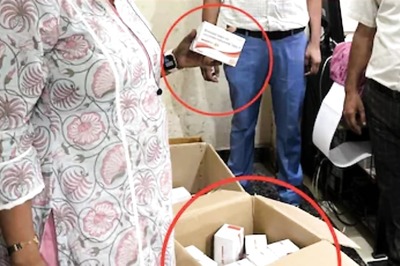'Surya Tilak' Spectacle: Sunlight Precision-Crafted to Illuminate Ram Lalla's Forehead on Ram Navami

views
On Each Ram Navami, a sophisticated arrangement of lenses and mirrors will be employed to direct a beam of sunlight into the innermost sanctum of the Ram temple in Ayodhya, converging it precisely on the forehead of Ram Lalla in the form of “Surya Tilak.”
This occurrence on the ninth day of the Chaitra month signifies the celebration of Lord Ram’s birth. Crafted by the scientists at the CSIR-Central Building Research Institute (CBRI), the “Surya Tilak” system is orchestrated to focus the sunlight onto the idol’s forehead for approximately six minutes starting from noon.
While speaking to PTI, CBRI chief scientist R Dharamraju said that The idol will be placed in the sanctum sanctorum of the upcoming temple during a consecration ceremony (Pran Prathistha) on January 22.
“To achieve this, an optical lens will be placed on the third floor of the temple which will channel the ray to the ground floor through a series of reflectors placed in pipes,” added the scientist.
Who Designed ‘Surya Tilak’ Mechanism?
The “Surya Tilak” was designed by a team of scientists led by S K Panigrahi. Senior Scientist at CBRI Debdutta Ghosh said the Indian Institute of Astrophysics gave inputs based on astronomical observations and also contributed to the mechanical and structural design for the “Surya Tilak”.
CSIR-labs were among the institutes that were involved in studies to carry out the structural analysis of the temple’s design to make it able to withstand strong earthquakes and also the impact of rains, harsh winters and scorching summers.
The CBRI was involved in conducting the 3D structure analysis of the temple design and it also suggested some modifications, Ghosh said.
“The sizes and shapes of the domes of the temple also were modified based on inputs provided by the CBRI,” he said.
Ghosh said CSIR-National Geophysical Research Institute at Hyderabad conducted the seismic hazard analysis of the temple site through ground penetration radar study and multichannel analyses of surface waves.
“The temple can withstand an earthquake of 8 magnitude,” Dharamraju said, adding that Ayodhya is located near the Himalayan region which is a known seismic zone.
Series of Sensors to be Installed in Temple
He said the CBRI will also install a series of sensors at the temple for its constant monitoring as the it will be exposed to rain, and extreme temperatures during summers and winters.
The CSIR-CBRI has displayed a model of the Ram temple at the India International Science Festival, which began on Wednesday at the Translational Health Science and Technology Institute.
(With inputs from PTI)
















Comments
0 comment